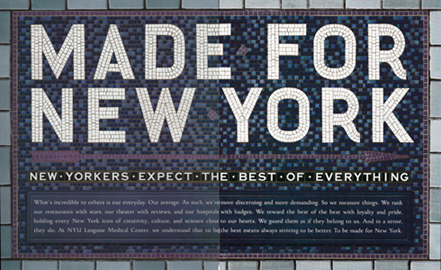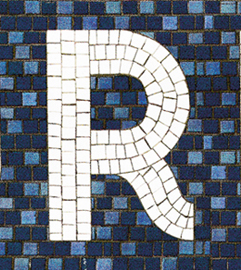

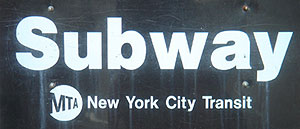
• History and statistics
• Activities
• Maps & diagrams
• The MetroCard
• Advertising in the cars and stations
• Art in the subway stations
• Tile art conundrum
The great equalizer
For one moment or two, corporate executives in polished shoes and three-piece suits stand shoulder to shoulder to someone wearing scuffed work boots and a tee-shirt. From two different backgrounds, but for a moment they share the same objective - the fastest and most efficient transportation to get where they are going. The doors open, they move apart and they go on their own expected journeys. But for that one great moment, all were one with the same immediate objective in life. They shared a common bond, probably the only time in their lives they will share such a bond. This may partly explain why New Yorkers are more tolerant and accepting of others - they share this commonality.
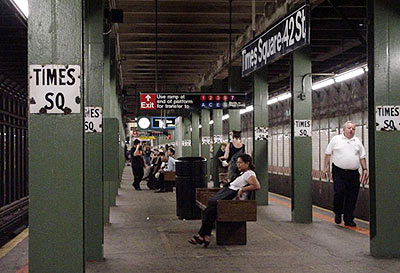
The subways of New York City officially opened for business at 7pm on the evening of October 27, 1904, at the City Hall station, but only after Mayor George McClellan had taken the first car on the line out for a spin, much to the chagrin of nervous IRT officials. Clifton Hood describes the scene on opening night in his 1993 book 722 Miles: The Building of the Subways: The night took on a carnival atmosphere, like New Year's Eve. Many couples celebrated in style by putting on their best clothes, going out to dinner, and then taking their first subway ride together. Some people spent the entire evening on the trains, going back and forth from 145th Street to City Hall for hours. Reveling in the sheer novelty of the underground, these riders wanted to soak up its unfamiliar sights and sensations for as long as possible. In a few instances high-spirited boys and girls took over part of a car and began singing songs, flirting, and fooling around. The sheer exuberance of opening night proved to be too much for others; although they bought their green IRT tickets and entered the stations like everyone else, these timid passengers were so overwhelmed by their new surroundings that they did not even attempt to board a train. All they could do was stand on the platform and gawk.
230 miles of track
6,200 subway cars
468 stations
31,180 entrance turnstiles
140,000 ads in the subway system
68 bridges
14 underwater tunnels
300,000 seats
169,000 people using Times Square station per week
5,800,000 average daily weekday ridership
1,499,000,000 yearly ridership
Birthday: October 27, 1904; 28 stations; 9.1 miles of track; City Hall to 145th Street.
Borough extensions: The Bronx in 1905, Brooklyn in 1908, and Queens in 1915.
Three systems merged to form the MTA (Metropolitan Transit Authority):
• IRT (Interborough Rapid Transit)
• BMT (Brooklyn Manhattan Transfer)
• Ind (Independent)
1. Tokyo: 2.863 billion riders
2. Moscow: 2.603 billion
3. New York City: 1.499 billion
4. Seoul: 1.466 billion
5. Mexico City: 1.441 billion
6. Paris: 1.373 billion
7. London: 971 million
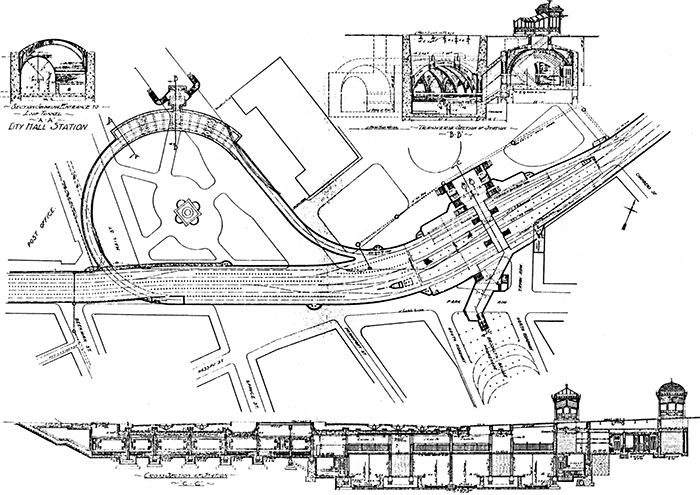
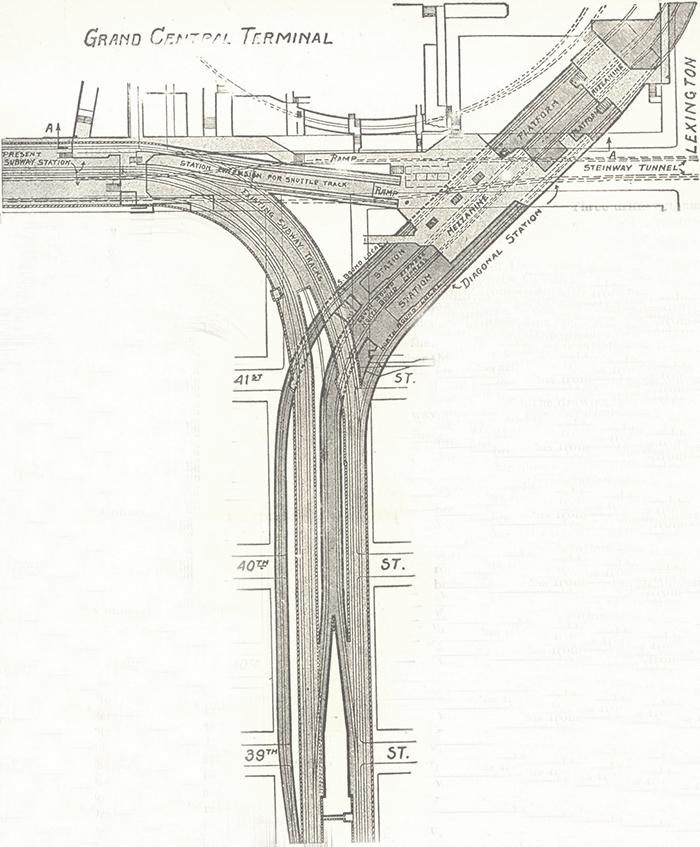
Activities in the subway car
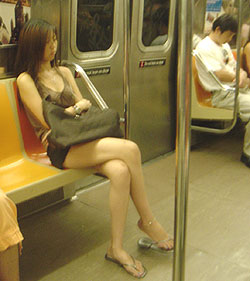
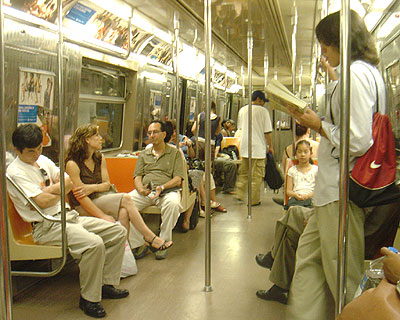
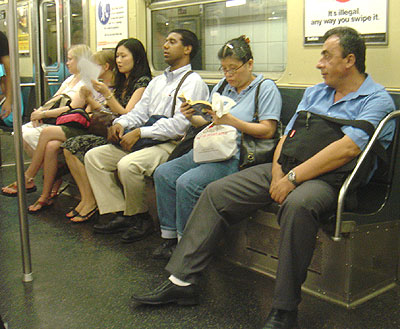
• Sitting in silence and observing
• Reading a book, magazine, or newspaper
• Working a Sudoku or crossword puzzle
• Listening to music on earpieces
• Talking
• Sleeping
One should not:
• Maintain unnecessary eye contact
• Peruse another's reading material
• Graze elbows or any other body parts
• Sing out loud to one's iPod
• Converse with other riders
• Leave trash on the train, take it with you
• Eat smelly foods (or anything)
• Take up more than 1 seat:
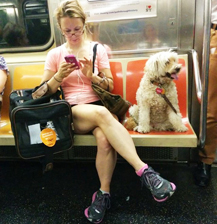
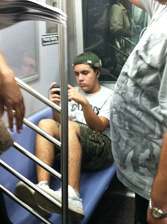
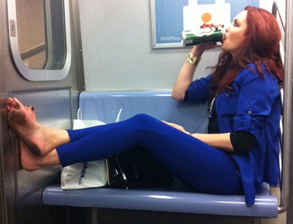
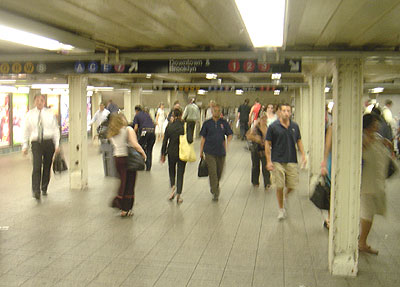
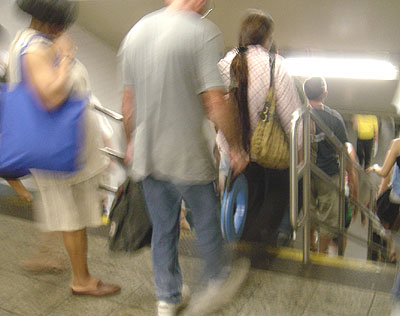
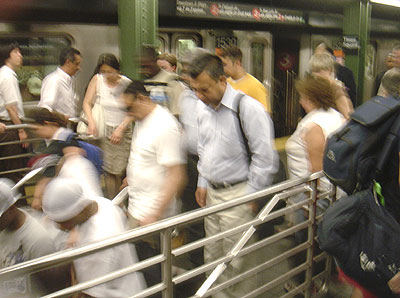
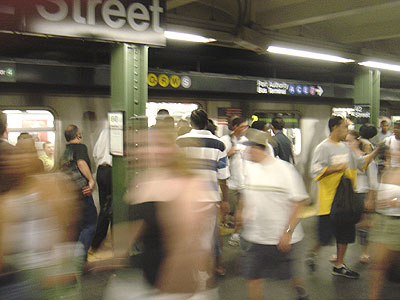
The sometimes hectic pace in the subway stations.
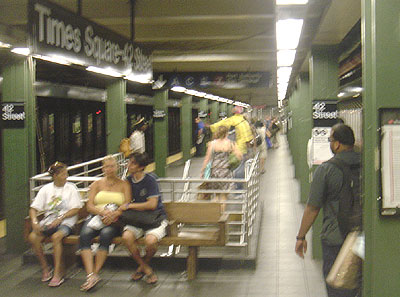
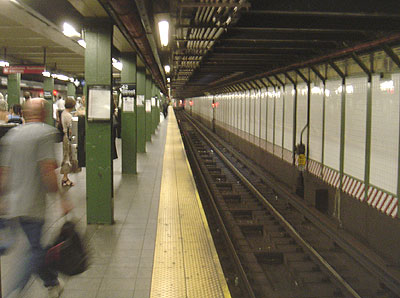

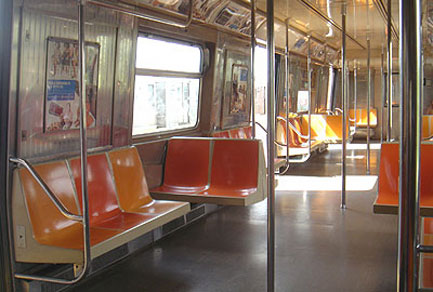
Maps & diagrams
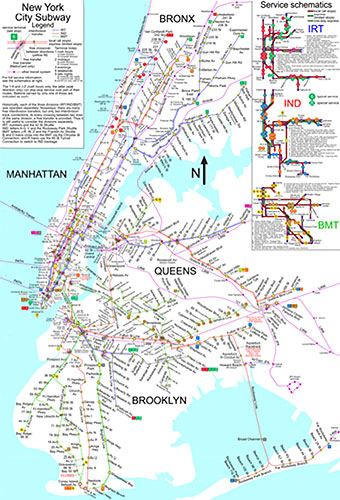
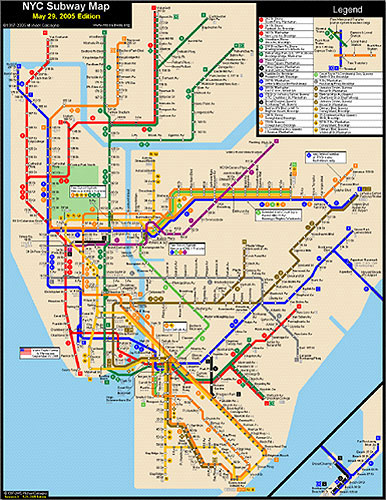
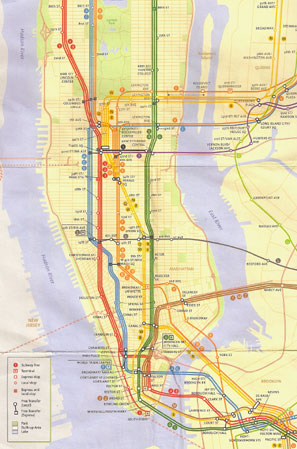
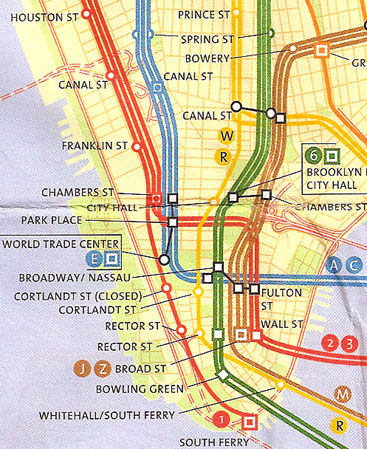
In 1972, New York City-based Italian designer Massimo Vignelli redesigned the New York Subway map, which persisted until 1979. There was influence from the London Underground map, created by Henry Beck in 1933. However, Vignelli took it farther, creating the now-famous intertwined wiring-diagram map of New York's vastly complicated subway lines. The result was a design solution of surprising beauty. But the level of abstraction presented problems - to make the map work graphically meant that a few geographic liberties had to be taken. Vignelli had planned a second map that would have been more tied to the actual above-ground geography, but the city never let him do it. Vignelli's beautiful and now classic map was replaced with a version that was not quite so stylized. The public couldn't quite navigate Vignelli's uncluttered version.
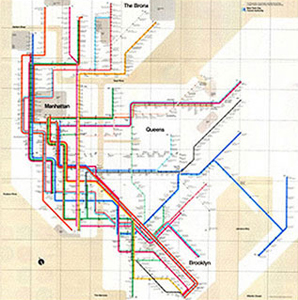
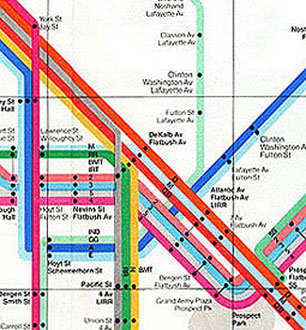
In late 2007, Men's Vogue magazine asked Vignelli to redesign his classic 1972 diagram and update it for 2008. Massimo and his team did just that. It was introduced in Men's Vogue in May, 2008. Still holding to the design principles, the new diagram is even clearer and less cluttered.
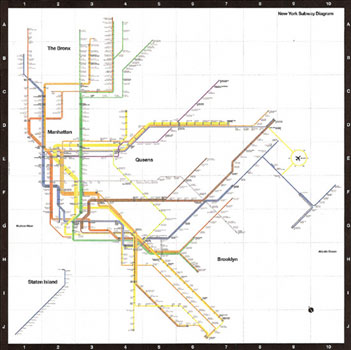
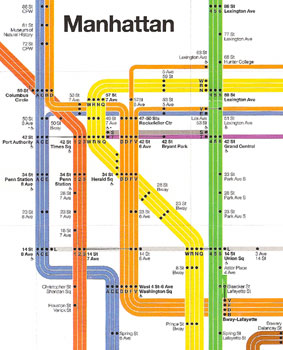
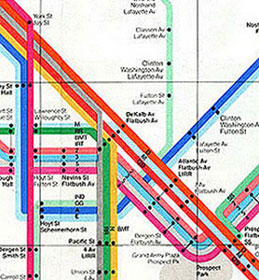
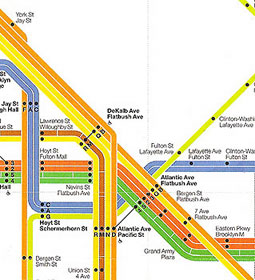
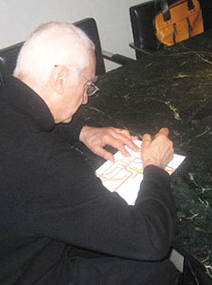
Side-by-side comparisons: 1972. 2008. Massimo signing copies for students during the 2008 Study Tour.
Below is a map from a research project at Columbia University that shows all the mass transit for the metro area. The NYC MTA has always shunned New Jersey and the commuter railroads on their maps. A bit unreasonable since NJ makes up a sizable portion of the metro population. The metro area doesn't stop at the Hudson River. So this prototype is an improvement. This version pays respect to Vignelli's 1972 diagram with the Beck-style orthogonal lines and lack of city detail. It even shows the AirTrans routes from JFK and Newark airports to the mass transit lines.
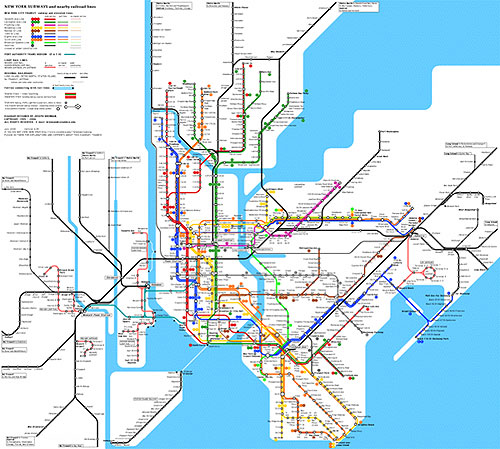
The MetroCard


The old days of nickel rides (now its $2.50) and tokens are long gone. With new technology, these credit card sized plastic cards have become the new way to enter a turnstile at a subway station. When I get to New York, I buy an unlimited ride MetroCard for a week or a month. There are 3 subway lines within a few blocks of my apartment and several more a few blocks beyond those (the lines converge towards the tip of Manhattan.) I started collecting expired MetroCards - I built three vertical sculptural columns from 735 recycled MetroCards collected over a period of several months. The cards take on a new life - from utilitarian access to aesthetic repetition. I have gotten into the habit of grabbing the expired cards that have been left in the stations. I don't know what to do with them. I checked at the Transit Center in Grand Central to see if the cards could be reused or recycled. They said no, they're just thrown away. Seems a waste so I'll probably continue to collect them. As of March, 2008, I had collected an additional 2,000 MetroCards that are waiting for some new life or new use.
Free subway rides?
From an article in New York magazine, 2007
Theodore Kheel thinks we've waited long enough for a transportation revolution - the 93-year-old labor lawyer has a plan: double the tolls on the bridges and tunnels, and the subways and buses would be free. Kheel first floated his idea in 1965. Kheel's Nurture New York's Nature Foundation has subsidized a $100,000 study by a group endearingly called the Institute for Rational Urban Mobility. An early look of its scheme reveals that inbound drivers would be charged $16, about what Londoners pay now. About 20 percent of drivers would then opt to leave their cars at home. The remaining tolls would more than replace the $2 fare we now pay. Fare-collection costs - now 6 percent of the MTA budget - would be diverted into handling the huge swell in ridership. “This is one of the major issues of our time. Right now, I've never seen the automobile traffic as dense as it is, and the cost of that is tremendous. We're not going to tell people not to ride automobiles; we're simply going to say you ought to pay your share."
Advertising in the cars and stations
There have been ads in the subway cars for decades - its a great source of revenue for the MTA. Advertisers can buy an entire car or one side - so their messages will dominate the environment. The fotos below show a clever campaign for the Bronx Zoo that dominated this car. The ads look like there is a zoo ad next to an ad for a legitimate retailer (like a book store, cheese shop, or tuxedo rental). Characters from the zoo ad are intervening in the fake retail ad.
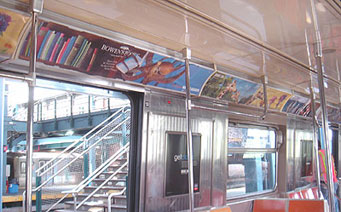
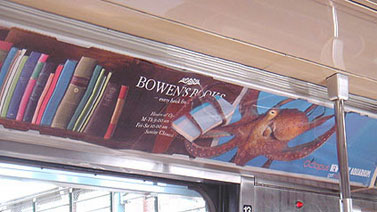

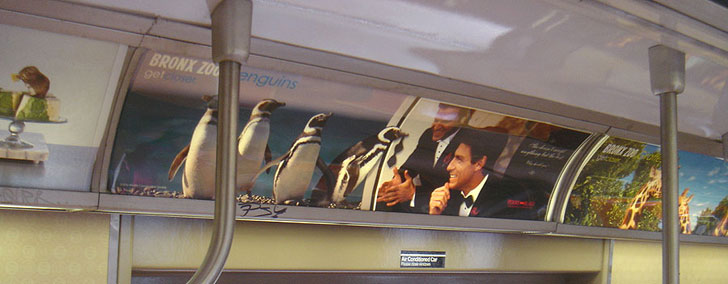
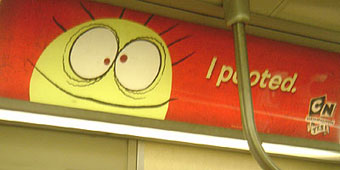
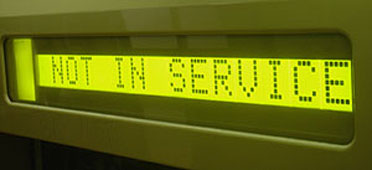
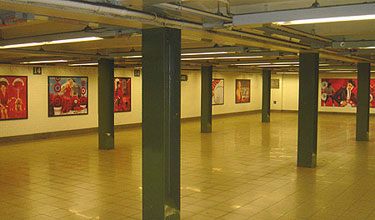
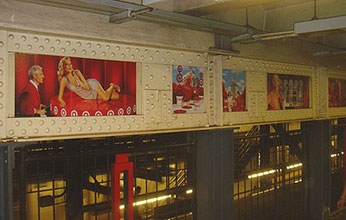
Ads for Target were all over the Union Square/14th Street Station - a hip young area with several converging lines. Some ads are in traditional framed spots, others were on vinyl and adhered to the steel beams. I counted about 40 separate ads and I probably didn't see them all. And - get this - there isn't even a Target store in Manhattan (although I suspect there will soon be).
Public Art in subway stations
Public art in the NYC subway stations is a very old tradition. Decorative elements in the stations originally were designed to reflect the naberhood above. Canal Street with Chinese characters, Fulton's steamship at Fulton Street, kinetic sculpture and reclaimed original mosaic tile art at Unions Square, etc.
NRW trains • Prince Street
The frieze at the Prince Street subway station celebrates the significance and individuality of the citizens of New York. It depicts 194 silhouetted people, taken from photographs of New Yorkers in all their variety, arranged as a 1200 foot narrative that contains smaller dramatic narratives within it. More than two thousand New Yorkers were photographed walking along the street - 194 were selected as the most evocative, varied, and visually readable. For the installation, some of the existing white subway tiles were removed and replaced with new identical tiles that had been cut out in the shape of the figures. Stainless steel, marble, and slate shapes were placed in those spaces like puzzle pieces, making it appear that the figures are embedded in the walls. The title, "Carrying On", refers to the figures carrying various objects; New Yorkers carrying on with their lives after 9/11, and the "notoriously opinionated and lively" New Yorkers who "really do carry on."
Title: Carrying On
Date: 2003
Artists: Janet Zweig with Edward del Rosario
Materials: water-jet cut stainless steel, marble, terrazzo, slate
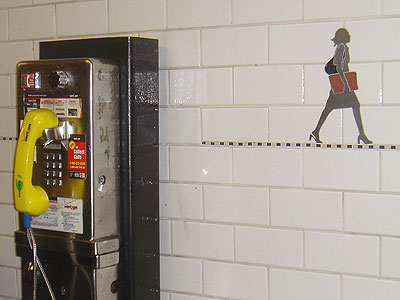
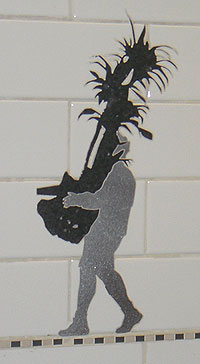
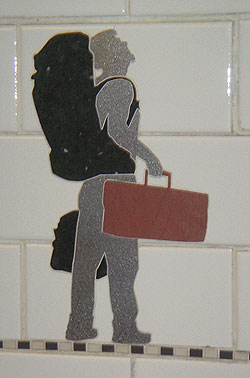
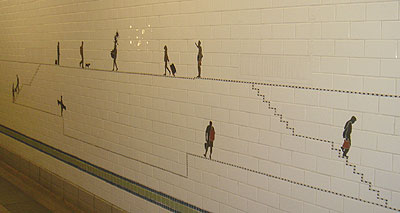
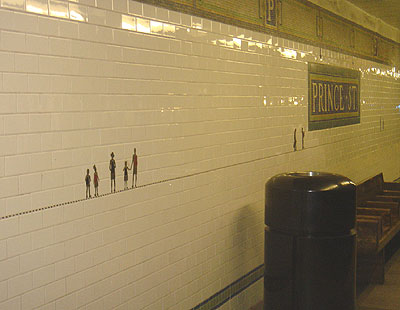
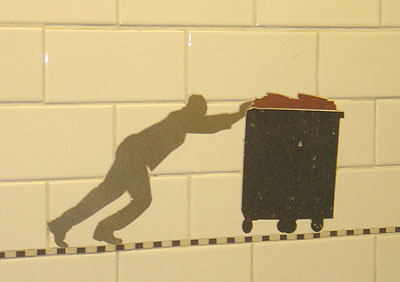
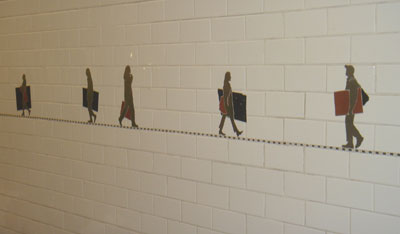
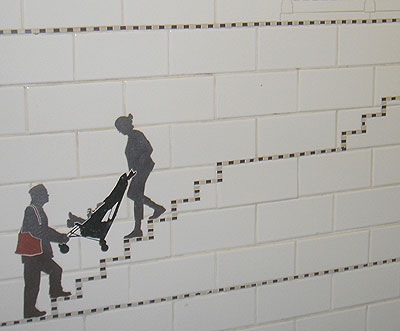
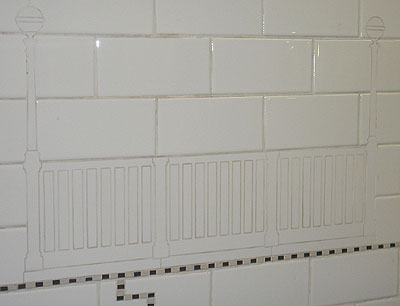
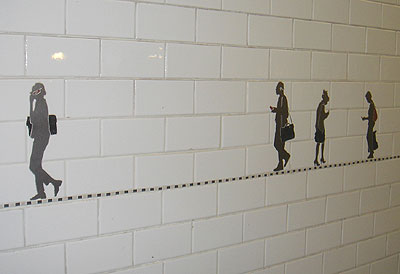
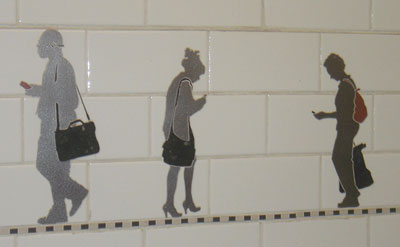
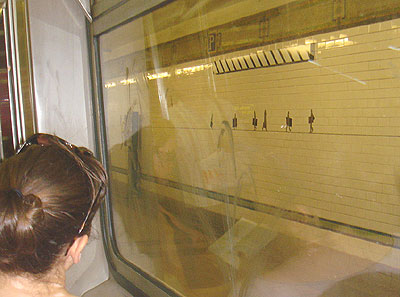
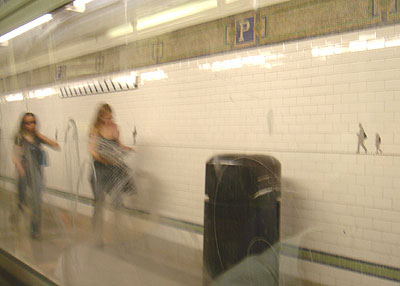
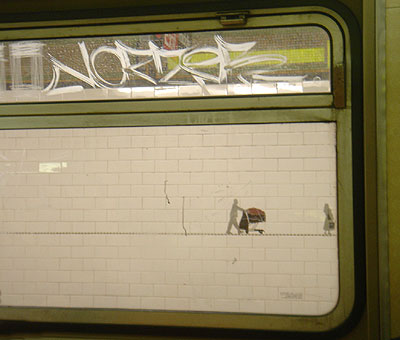
6 train • Astor Place station
Astor Place has two works of art - the original station identifying tiles show a beaver (John Jacob Astor began his fortune in beaver pelts) shown in the upper rite of the first foto below. Later, Milton Glaser created artwork that complements the existing historic fabric while making a bold and modern statement. Glaser described his approach as, "basically a variation on the existing forms. By extracting fragments of the motifs on the tile panels, enlarging their scale, and placing these pieces in a random pattern, they take on the appearance of a puzzle."The result is a series of porcelain enamel panels in geometric patterns and color that echo the historic elements but present them in an entirely new way. Milton Glaser went to school at Cooper Union which is above this station.
Title: Untitled
Date: 1986
Artist: Milton Glaser
Material: Porcelain enamel on platform walls
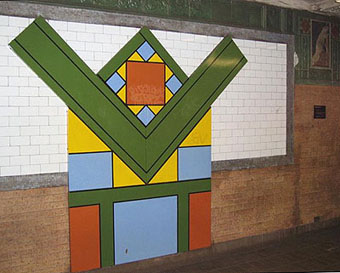
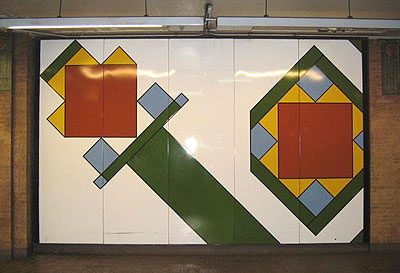
NR train • 23rd Street
From the 1880s through the 1920s, 23rd Street was a major vaudeville, entertainment, and cultural district, and "Ladies Mile," the fashion and department store haven of the time, was located nearby. Keith Godard represents the area through the various hats they might have worn. The celebrities he had in mind include Jim Brady, Oscar Wilde, Sara Bernhardt, Mark Twain, and Lillian Russell. Godard says, "In addition to bringing back memories of the specific time period and people and appealing to the viewers on a more common level as fascinating hats, this design can also serve as an interactive, playful, and witty landmark." The hats are at the approximate height of the figure and labeled with text beneath.
Title: Memories of Twenty-Third Street
Date: 2002
Artist: Keith Godard
Material: Glass mosaic on platform walls
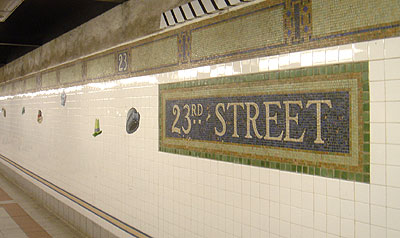
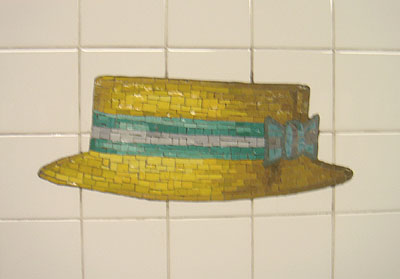
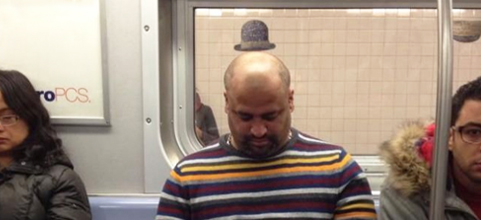
ACE trains • 14th Street
The scores of figures created by Tom Otterness invigorate and transform the transit environment into a place of joy and whimsy. His small-scale sculptures invoke the subway and lore of the city and include an alligator rising out of a sewer to devour a man, workers carrying oversize versions of the tools used to build the subways, and people sneaking under fences to watch the construction or sweep up piles of pennies. There are also colossal feet and a totem-like sculpture whose human features are formed into the shape of a telephone. Otterness placed his creations in unexpected places-beneath stairs and pillars, hanging from the ceiling, and on benches and railings-to surprise and delight riders as they come upon these humorous and captivating inhabitants.
Title: Life Underground
Date: 2001
Artist: Tom Otterness
Material: Bronze sculpture on railings, beams, and columns throughout station
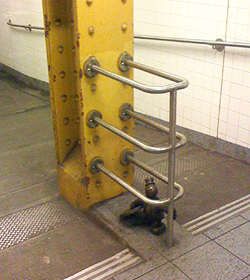
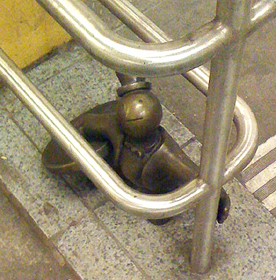
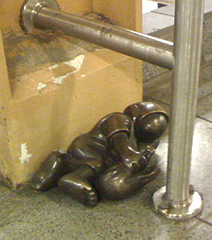
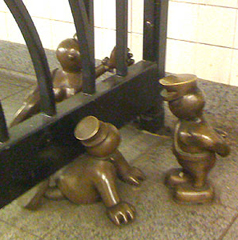
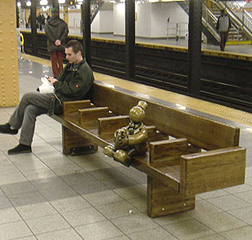
123SNRQW trains • Times Square
Lichtenstein is famous for his enlargements of a comic-book-dot style of outrageous moments in life. This project, begun in 1994, includes icons of a futuristic Manhattan.
Title: Times Square Mural
Date: 2002
Artist: Roy Lichtenstein
Material: 16 panels, porcelain enamel on steel, 6' x 53'
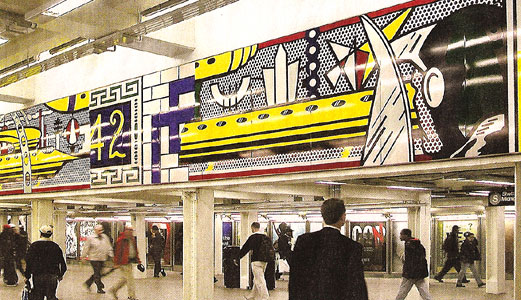
Miscellaneous
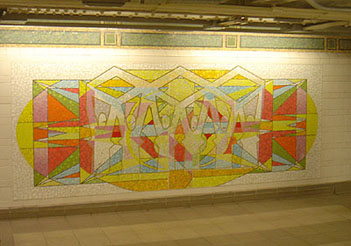
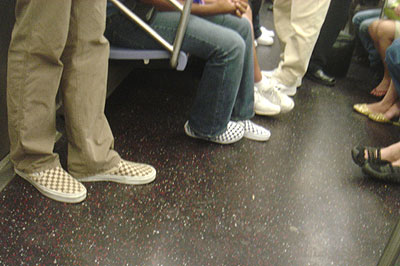
A tile art conundrum
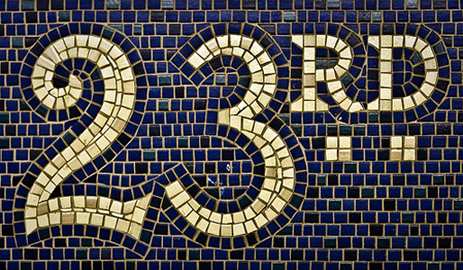
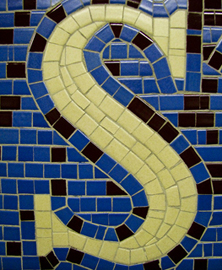
The text in the older station name tiles have a border around the letters in the same colors as the background. Some of the newer ones have the rows of background tiles butt right up to the letterforms, as in this ad:
